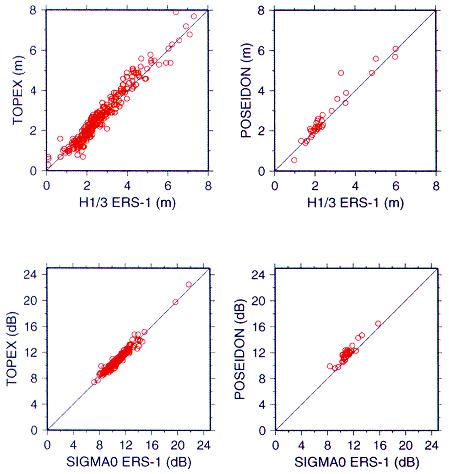ERS-1 and Topex/Poseidon wave heights and backscattering coefficients compare well
Pierre Queffeulou (Ifremer, France)
From September 23 to December 1, 1992, we did a comparative study of Topex/Poseidon and ERS-1 data. The Topex/Poseidon data was the first nine cycles over the Atlantic, (70°N-70°S, 100°W-30°E).
The IGDR-M, version 1, Topex/Poseidon data was supplied as simplified files by the Cnes Aviso/Altimetry team under the Quick-look project. The ERS-1 data was the Fast Delivery Products (FDPs) real-time data from the European Space Agency (ESA) and archived at Cersat. We chose points where the ground tracks of the two satellites crossed within one-hour intervals. The comparison data set consisted of the closest Topex/Poseidon and ERS-1 bins, each bin being a one-second average of the elementary Ku-band altimeter measurement by each satellite. The distance between bins was under 30 km for all the data, and under 5 km in 93% of cases. We selected 323 validated pairs: 32 Poseidon and 291 Topex.
The comparisons show that the two satellites' measurements correlate well, as illustrated in the graphs below, Topex on the left, Poseidon on the right.
For the backscattering coefficient, the mean differences are 0.07 dB between Topex and ERS-1 (rms deviation 0.32 dB) and 0.85 dB between Poseidon and ERS-1 (rms deviation 0.47 dB). This suggests a mean bias of 0.78 dB between Topex and Poseidon.
For the significant wave height, the calibration relationship derived during the RENE 91 validation experiment was applied to the ERS-1 FDP measurements (Hcorr = (HFDP - 0.37) / 0.84). The corrected ERS-1 and Topex/Poseidon measurements compare very well.
The mean differences are 0.02 m between Topex and ERS-1 (rms deviation 0.33 m) and 0.15 m between Poseidon and ERS-1 (rms deviation 0.35). These first results are generally satisfactory.





